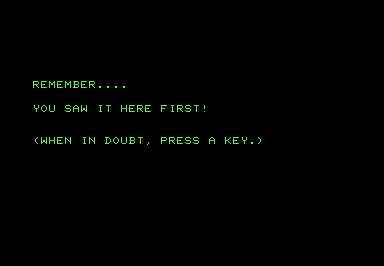CURSOR #14 – October 1979

COVER
Author: Chuck Cares
Original file name: COVER14
PRG file: cover14.prg
This month's cover starts out by drawing a simple PETSCII crate, but if you let it run for a bit, the corners begin to shift to create variations of the impossible box illusion.
Pressing SPACE takes you to the table of contents for the issue.

MATCH
Author: Julia Hallford
Original file name: MATCH
PRG file: match.prg
MATCH is a computer version of the memory card game
Concentration
for up to four players. Players take turns flipping over pairs of cards looking for matched symbols.
The similarity between some of the PETSCII glyphs you are trying to match adds to the difficulty.
You can play this one as a solitaire game, and the PET will
keep track of the number of turns
it takes you to find all the matching pairs.

SEARCH
Author: Hal Carey
Original file name: SEARCH
PRG file: search.prg
This program takes a list of words and builds a word-search puzzle, which is then sent to your printer. The intention is that you solve the puzzle the old-fashioned way—with a pencil (or a pen, for those who live life on the edge). While it's kind of neat to watch the PET generate the puzzle one word at a time, the title screen's warning that THIS PROGRAM NEEDS A PRINTER! is absolutely true—without a printer, there's not much to see here. I wasn't able to troubleshoot the printer emulation in Vice so I can't show you what a finished puzzle would look like.

BAT!
Author: C. T. Nadovich
Original file name: BAT!
PRG file: bat.prg
In BAT!, you fly what the game's flavour text calls a "radio-controlled
superbat", eating bugs to maintain your energy. When your calorie count reaches zero, it's
game over; your score is how long your are able to remain airborne. Control takes a bit of
effort to master: your bat has momentum, bounces off walls, and is affected by gravity
which is
set to 9.8—a
neat detail
that most people would never notice.
The sound in this game suits the action. I didn't play for long, but overall I think this
one can be fun for a quick game or two. However, this game does PEEK memory location
151 to read the keyboard (automatically corrected to location 515 on Revision 1 ROMs), so it is
not compatible with the 4016.

MORSE
Author: Norman Parron
Original file name: MORSE!
PRG file: morse.prg
MORSE! is a drill program for practicing
Morse code.
The student sets the transmission speed at the beginning of each session; I know
no Morse code aside from "SOS", so I set the speed as slow as possible, which was helpful.
This program uses CB2 sound effectively, with short and long tones corresponding to the
"dots and dashes" that make up the Morse-code representation of each character. While this
program is okay for learning Morse code—in the short time I played with it,
I learned a handful of numbers and the letter 'L'—I think it is more useful
as practice for someone who already knows the system and wants to get better
at it. To learn from scratch, I'd want to see a graduated system where letters are
introduced a few at a time, and the ability to practice on real words instead of
random strings of characters. Unfortunately, there's not enough memory on the 8K PET
to add these features to the program.

COPS
Author: Glen Fisher and Sheila Dolgowich
Original file name: COPS
PRG file: cops.prg
COPS is based on an asymmetrical cops-and-robbers game known as
"the hamstrung squad car" discussed in Martin Gardner's Mathematical Games
column in Scientific American (February 1967, p. 116). I'd link to the
article, but access to back issues is limited to subscribers (about $30 a year
at the time of writing). If you search for "hamstrung squad car", you can learn
more about the mathematical ideas that underly this game.
This PET implementation is functional, but the presentation is bland. The PET does not participate in the game; you need two players for this one. There's enough leftover RAM that Fisher could have programmed the computer to play as the robbers with some rudimentary evasion logic.

COMING
Author: Uncredited
Original file name: COMING
PRG file: coming.prg
This bonus program "reflects a bit of late night craziness." This program cycles through a bunch of pretend startup screens so you can try to trick your friends into thinking your PET boots up to development environments for Pascal, APL, or COBOL. These languages would all be supported for real by the SuperPET, a computer that would not be announced until May 1981, nearly a year and half after this program was written.
